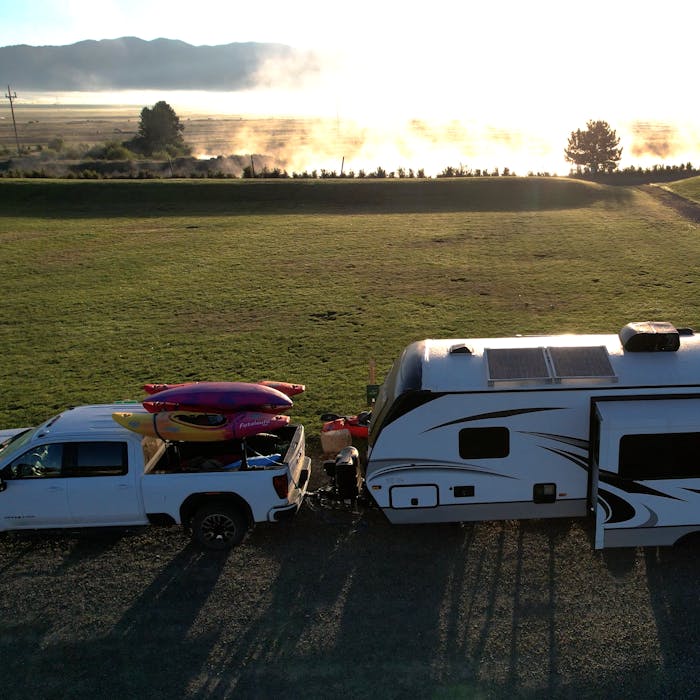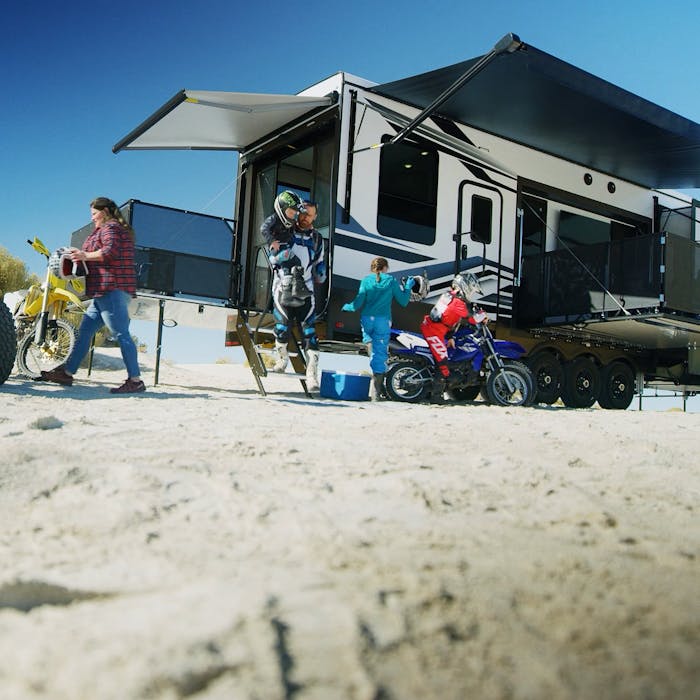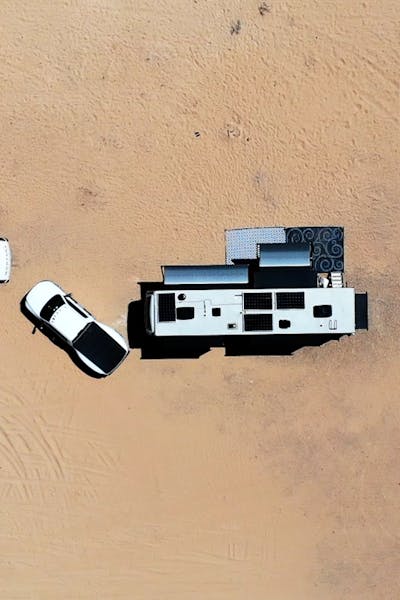There is a lot to learn when it comes to RV solar power. We've tapped the pros at The Keystone Innovation Lab to answer some of your most frequently asked questions. Read on for information on solar power basics, solar panels, batteries, inverters, solar charge controllers, and battery shunts.
Have a question we haven't answered? Email it to us at ownerrelations@keystonerv.com.

Solar Power Basics
What is solar power?
The term "solar power" or "solar energy" is referring to the process of using photovoltaic cells to convert energy from the sun into electric power.
What is needed for solar power?
This requires a minimum of a solar panel, solar controller, battery(s) as well as properly sized wires/cables and circuit protection (fusing).
Why do I need solar power?
Solar power is used to replenish (or charge) battery(s) without using the shore cord/converter or another AC power source such as a generator.
Does solar power work at night?
While electricity from your battery can be used at night, no, a solar power system does not produce more electricity when it’s dark.
Can I expand my solar power capability?
All SolarFlex systems were designed to be expandable (providing you have open roof space). We recommend using a solar power calculator (Google it) to determine how much energy you will typically use/need for your type/style of camping. Once that is determined, your Keystone dealer can outline the different expansion options available. More information is also available at www.keystonerv.com under SolarFlex.
How do I add solar power to my RV?
All Keystone models come standard with or have the option to upgrade to a SolarFlex package. The SolarFlex 220 package includes a 200 Watt Solar panel, 15 Amp MPPT Smart Solar Controller, 30 Amp Solar Roof Ports, and are pre-wired to add an inverter. Depending on the brand and model, 400i, 600i-L, and 1200i-L (Montana only) could be optioned. Regardless of the SolarFlex package that is on your Keystone RV when built, we designed SolarFlex to be customized and expanded by your Keystone dealer to fit a wide variety of camping needs. For more information, visit SolarFlex at www.keystonerv.com or contact your local Keystone dealer to get you started.
Do I need to do anything to my camper before plugging into the campsite with solar power?
No, solar power charging is completely independent of the shoreline cord/converter. The solar charge controller reads the level of the battery, then only allows through the charge actually needed by the battery so you never have to worry about overcharging or damaging your battery.
What do I do if it is raining cloudy or no sun?
In this situation, there are only 2 options: 1) Practice energy management to reserve your battery capacity until which time the sun becomes available again 2) Recharge the battery(s) by shore cord/converter, generator, or running the tow vehicle while the pigtail (7-Way) is plugged into the RV. Note: Using the tow vehicle may not work with Lithium, see FAQ regarding charging the battery while driving down the road.
Solar Panels
How much wattage should I see from these? (200W or 300W Panels Only)
Best case/Perfect conditions: 180 watts (200 Watt panel) and 270 Watts (300 Watt Panel). However, conditions are significantly variable: 1) Battery(s) State of Charge (SOC)-The higher the SOC, the less charge being sent by the solar controller because the battery doesn’t need it, the lower the SOC, the more the charge that is sent 2) How much sun is actually reaching the solar panel - time of day (sun low), time of year (fewer hours of total sun), angle of the panel to the sun, trees/leaves blocking how much sun reaches the panel 3) How clean is the solar panel. These are just a few….
What maintenance is needed for my solar power system?
Your solar power system is relatively easy to maintain: 1) Keep your panels clean so they can absorb as much sunlight as available 2) follow Keystone’s requirements to inspect/maintain roof seams/joints/attachments as outlined in the Owner’s Manual.
How do I clean them?
It is best to clean the panels with only a wet rag, then wipe them dry with a soft cloth.
Batteries
What batteries are recommended for solar power applications?
Lead Acid, Absorbed Glass Mat (AGM), or Lithium-ion can be used for solar power applications.
What is the difference between Lead Acid, AGM, and Lithium?
Lead Acid (oldest technology invented in 1859): a rechargeable battery with dilute sulphuric acid as the electrolyte that allows for discharge and recharge.
AGM (newer technology): is an advanced lead-acid battery that has a longer life span, higher electrical loads, and quicker recharge time than the standard Lead Acid Battery.
Lithium (newest technology): a rechargeable battery that uses lithium ions as the primary component of its electrolyte.
How are lithium batteries different from traditional lead-acid batteries?
Lead-acid is a tried-and-true technology that is economical, but requires regular maintenance and doesn't last as long. Lithium is a premium battery technology with a longer lifespan, higher efficiency, and better performance and is lighter weight. Properly used and maintained, they can last as much as 7-10 years.
Which battery type is better, Lead-acid, Lithium, or AGM?
When using multiple 120-volt components or those that consume more energy (higher load such as a microwave, coffee maker, or hairdryer) for longer periods, lithium wins hands down. Lithium not only allows you to pull more energy at a faster rate but also recharges faster. However, we know that Lithium may not be practical for everyone, so if you are someone who typically uses their RV for a weekend at a park or unplugged for short periods, not using higher load 120-volt components much, then a couple of AGM batteries will most likely serve you well. If traveling often, longer trips, using multiple or higher load 120-volt components with no access to plug in a shore cord or run a generator, Lithium is well worth the additional cost.
Important Note: Not all “Lithium” batteries are equal. There are several different chemical combinations that all fall into the lithium-ion category. The lithium solution we offer is LiFePo4. This is a category where cheaper is not necessarily better.
Can I add more battery(s) later?
Yes, as long as they are the same type and size as what is currently installed and wired in parallel.
Will my RV battery charge from my tow vehicle while I am driving down the road?
Tow vehicles may be equipped with a “smart alternator” which is designed to read the battery voltage and only send a charge if necessary. Because Lithium batteries maintain high voltage even while being depleted of energy, the “smart alternator” can misread the need and not recharge the RV battery(s) while driving. There are aftermarket products that can help overcome this if charging while driving is important for your application.
For more information please watch these videos from Battle Born Batteries:
- FAQ: Can I charge my batteries using the alternator? l Battle Born Batteries https://youtu.be/VY2b71zoyvg
- FAQ: Comparing DC to DC Chargers l Battle Born Batteries https://youtu.be/GpNDeQN4O-o
Why do my Lithium batteries only charge to 80%?
The Smart Solar Controller battery preset is incorrect and should be set to Lithium Iron Phosphate (LiFePo4). Use the Victron Connect app to change this setting. Instructions can be found in your SolarFlex quick start guide.

Inverter
What is the difference between a converter and an inverter?
A converter takes 120-volt Alternating Current (AC) and converts it to 12-volt Direct Current (DC) which allows you to run your 12-volt components in your RV. An Inverter takes 12-volt Direct Current (DC) from your properly charged RV battery(s) to create 120-volt Alternating Current (AC) to run 120-volt components in your unit.
Are there different types of inverters?
We use two types of inverters, 1) Stand-alone inverters - converts DC power from the batteries to AC power for the outlets or other 120-volt appliances. 2) An inverter charger - does the same but also converts outside AC power (shore power or from a generator) to DC power to charge the RV battery(s).
Does my inverter need to be turned on if not in use?
The inverter disconnect and inverter can be left on during normal use which will allow it to automatically engage in the event you are disconnected from shore cord power. Both should be turned off while servicing the 120-volt system and during storage.
Why do I see voltage, but no amps from my solar controller?
If the RV battery(s) are fully charged and there are no large load demands on the system, the solar smart controller limits the amount of amperage sent to the battery to avoid overcharging and damaging it.
My RV has SF200, it also came with the option for a Residential refrigerator powered by a 2000W inverter, are my inverted outlets powered by the same inverter?
The inverter that comes with your residential refrigerator will be hooked up to the SolarFlex 200’s inverted loop in the factory, so up to seven 110v outlets in these coaches will be able to operate using power from the battery.
Inverter Disconnect
What is the big red disconnect switch?
This disconnects the power between the batteries and the Inverter ONLY. This does not disconnect the battery power from the rest of the 12-volt components in the unit.
When do I use it?
Inverter disconnect should only be turned off along with the inverter (if equipped) when the 120-volt system is being serviced or the unit is being put in storage.
Solar Charge Controller
What is a solar charge controller?
The Smart MPPT controller is what is used to regulate the energy the solar panel collects that is passed through to the battery. When the battery(s) are in a discharged state, the controller will allow maximum power through to recharge the battery(s) as fast as possible. When it senses the battery(s) are fully charged, it will significantly reduce/stop what power is allowed through to avoid overcharging or damaging the battery(s).
Do I need to shut off my solar controllers if I am plugged into shore power?
No, the solar power system and shore power system are separate. The MPPT solar controller(s) offered all work in conjunction with all other charging sources. Since the controller senses the battery needs, they will avoid overcharging and damaging the battery(s).
Why do you use multiple, smaller controllers instead of a single larger controller?
There are a couple of reasons we set our solar power installs up with multiple smaller controllers in place of a single larger controller.
- Breaking up large arrays allows us to use smaller gauge wire reducing the weight being added to the coach.
- Using two 50 amp controllers allows for the array to be on 2 completely independent circuits giving you added peace of mind that whether due to shade or damage occurring to one of the circuits, the other is working!
How to reset the solar charge controller?
This applies to the Jaboni Power product only. There is a reset button on the side of the solar controller. Press and hold for 3 seconds, then release. To reset the remote display, simultaneously press the up and down arrows with the power button.
SmartShunt
What is a battery shunt (SmartShunt) and what does it do?
A shunt is a precision resistor that allows you to monitor your battery(s). It measures battery voltage and current (amperage). The Victron SmartShunt we use records the battery(s) recharging rate and energy consumption at that moment in time to calculate the % of battery charge and the time remaining before the battery(s) are discharged. It also keeps track of historical data, such as deepest discharge, average discharge, and the number of charge/discharge cycles.
How do I view information?
Using the built-in Bluetooth broadcasting to link a smartphone or tablet to the Victron Connect app.
What does this information on the app mean?
SOLAR: What is being sent to recharge the battery(s)
- State of Charge - the battery(s) “state of charge” % (out of 100%)
- Voltage - Volts going to recharge the battery(s)
- Current - Amps going to recharge the battery(s)
OUTPUT: How much is being consumed or taken out of the battery(s)
- Voltage -Volts being consumed
- Current - Amps being consumed
- Power - Watts being consumed
- Consumed AH (Amp Hours) - Total Amp Hours (AH) consumed for that day
- Time Remaining - Estimated time remaining before the battery(s) are discharged
INPUT
- This feature is not used in this application
Questions About Your SolarFlex Packages
Why can’t I build out my SolarFlex 200 to be like the SolarFlex 400i?
Keystone RVs with the SolarFlex 400i package have a second inverted loop, 120 Volt pre-wire to the primary roof A/C and a dedicated circuit breaker that isn’t included in the SolarFlex 200 package. While owners could technically add these items to the RV after purchase, it would be a rather large and expensive installation. While one can’t completely turn SolarFlex 200 into SolarFlex 400i, you can easily match the solar power collection by adding a second 200w panel, increase charging speed by upgrading to a 30 amp solar controller, and power your 110v outlets by adding a 2000 watt inverter. The only thing that is really missing would be the components necessary to run the RV’s air conditioner. Please see the “expand your system” section of the SolarFlex 200 page for a full list of upgrade options.
Why can’t I build out my SolarFlex 400i to be like the SolarFlex 600i-L?
SolarFlex 600i-L features a different distribution panel with built-in sub-panel, additional 10/2 wiring, and a lithium ion battery that aren’t included in the SolarFlex 400i package. These components are easy to include during the build process, but much more difficult and expensive to add after delivery. However, the SolarFlex 400i package can be easily expanded to provide much of the functionality of SolarFlex 600i-L by upgrading the solar charge controller, adding additional solar panel(s), adding another inverter, or upgrading the inverter, adding battery capacity, and upgrading to a soft start air conditioner. For a complete list of expansion options and parts recommendations, please see the “expand your system” section of the SolarFlex 400i page.
